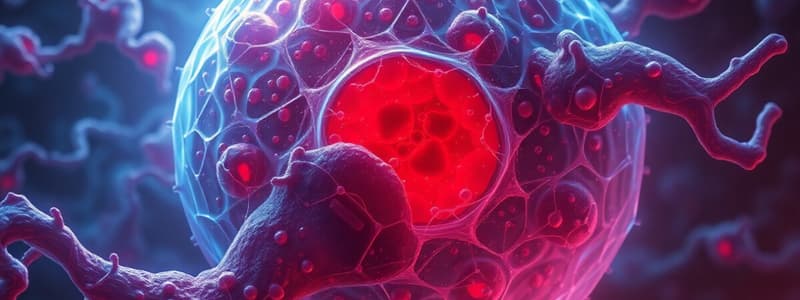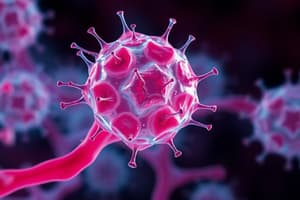Podcast
Questions and Answers
Which of the following best describes the difference between pluripotent and multipotent cells?
Which of the following best describes the difference between pluripotent and multipotent cells?
During hematopoiesis, which of the following cell types is derived from the myeloid branch?
During hematopoiesis, which of the following cell types is derived from the myeloid branch?
Which of the following is the correct sequence of events in phagocytosis?
Which of the following is the correct sequence of events in phagocytosis?
What is the role of myeloperoxidase found in neutrophil granules?
What is the role of myeloperoxidase found in neutrophil granules?
Signup and view all the answers
How do neutrophils continue to function effectively even in the absence of oxygen within infected tissues?
How do neutrophils continue to function effectively even in the absence of oxygen within infected tissues?
Signup and view all the answers
Which leukocyte is characterized by a multi-lobed nucleus (typically 2-5 lobes) connected by fine chromatin filaments and cytoplasm with neutrally staining specific granules?
Which leukocyte is characterized by a multi-lobed nucleus (typically 2-5 lobes) connected by fine chromatin filaments and cytoplasm with neutrally staining specific granules?
Signup and view all the answers
A patient's blood smear shows a high number of cells with kidney-shaped nuclei and lacy chromatin. Which type of leukocyte is most likely elevated?
A patient's blood smear shows a high number of cells with kidney-shaped nuclei and lacy chromatin. Which type of leukocyte is most likely elevated?
Signup and view all the answers
Which type of leukocyte is primarily responsible for killing antibody-coated parasites through the release of granule contents?
Which type of leukocyte is primarily responsible for killing antibody-coated parasites through the release of granule contents?
Signup and view all the answers
A patient presents with symptoms of a severe allergic reaction. An elevated count of which type of leukocyte would be most indicative of this condition?
A patient presents with symptoms of a severe allergic reaction. An elevated count of which type of leukocyte would be most indicative of this condition?
Signup and view all the answers
How do NK cells differentiate between healthy and infected cells?
How do NK cells differentiate between healthy and infected cells?
Signup and view all the answers
Which leukocyte plays a critical role in bridging the innate and adaptive immune responses by activating T cells?
Which leukocyte plays a critical role in bridging the innate and adaptive immune responses by activating T cells?
Signup and view all the answers
What is the primary function of mast cells in the context of parasitic infections?
What is the primary function of mast cells in the context of parasitic infections?
Signup and view all the answers
Which of the following correctly lists the leukocytes in order from most to least plentiful in the blood?
Which of the following correctly lists the leukocytes in order from most to least plentiful in the blood?
Signup and view all the answers
Pathogen-associated molecular patterns (PAMPs) MUST have which of the following characteristics from the perspective of the host's immune system?
Pathogen-associated molecular patterns (PAMPs) MUST have which of the following characteristics from the perspective of the host's immune system?
Signup and view all the answers
What is the immediate consequence of Pattern Recognition Receptor (PRR) activation on innate immune cells?
What is the immediate consequence of Pattern Recognition Receptor (PRR) activation on innate immune cells?
Signup and view all the answers
Flashcards
Multipotent
Multipotent
Cells that can give rise to multiple cell types, but not all.
Hematopoiesis
Hematopoiesis
Process of generating blood cells from stem cells.
Phagocytosis
Phagocytosis
The process where cells engulf and digest particles like bacteria.
Neutrophil granules
Neutrophil granules
Signup and view all the flashcards
Neutrophil fate post-phagocytosis
Neutrophil fate post-phagocytosis
Signup and view all the flashcards
Neutrophils
Neutrophils
Signup and view all the flashcards
Monocytes
Monocytes
Signup and view all the flashcards
Macrophages
Macrophages
Signup and view all the flashcards
Eosinophils
Eosinophils
Signup and view all the flashcards
Basophils
Basophils
Signup and view all the flashcards
Natural Killer (NK) Cells
Natural Killer (NK) Cells
Signup and view all the flashcards
Pathogen-associated Molecular Patterns (PAMPs)
Pathogen-associated Molecular Patterns (PAMPs)
Signup and view all the flashcards
Pattern Recognition Receptors (PRRs)
Pattern Recognition Receptors (PRRs)
Signup and view all the flashcards
White Blood Cell Count Ratio
White Blood Cell Count Ratio
Signup and view all the flashcards
Infected vs. Healthy Cells
Infected vs. Healthy Cells
Signup and view all the flashcards
Study Notes
Multipotent and Pluripotent Cells
- Multipotent cells can differentiate into multiple cell types.
- Pluripotent cells can differentiate into all cell types in an adult organism.
Hematopoiesis
- Hematopoiesis is the generation of blood cells.
- Myeloid lineage:
- Granulocytes: neutrophils, eosinophils, basophils
- Monocytes: macrophages, dendritic cells, mast cells
- Lymphoid lineage:
- Common T-cell/ILC precursor:
- Common ILC precursor: NK cells, ILC1, ILC2, ILC3, LTi
- Common T-cell precursor: CD8 T cells, common CD4 T-cell precursor
- Treg cells, TH17 cells, TH2 cells, TH1 cells
- B cells
- Common T-cell/ILC precursor:
- Erythroid (megakaryocyte-erythroid precursor cell) lineage:
- Erythroblast: erythrocytes
- Megakaryocyte: platelets
Phagocytosis
- Phagocytosis is the cellular internalization of particulate matter (e.g., bacteria).
- Process:
- Chemotaxis
- Adherence (PAMP recognition)
- Membrane activation ("danger" signal)
- Phagocytosis initiation
- Phagosome formation
- Fusion
- Killing and digestion
- Release of degradation products
Neutrophil Fate After Phagocytosis
- Neutrophils die in tissues and are engulfed/degraded by macrophages.
Neutrophil Granules
- Primary (azurophilic) granules:
- Myeloperoxidase (creates "green" pus)
- Hydrogen peroxide + chloride → hypochlorous acid (bactericidal)
- Defensins, bactericidal permeability-increasing (BP) protein, cathepsin G
- Secondary granules:
- Lactoferrin
- Lysozyme
- Alkaline phosphatase
- Membrane-bound cytochrome b558
Characteristics of Immune Cells
- Neutrophils: 2-5 nuclear lobes, pink/grey cytoplasm, abundant glycogen, multi-lobed nucleus
- Macrophages: Large, lightly stained kidney-bean shaped nucleus, lacy chromatin, small dense granules.
- Monocytes: Migrate to connective tissue, become macrophages.
- Eosinophils: Kill antibody-coated parasites, abundant in intestinal mucosa and lungs, increased in parasitic infections, stimulated in allergic reactions by mast cells.
- Basophils: Control immune responses to parasites, longest-lasting granulocyte (2 weeks), histamine, leukotrienes, heparin, involved in hypersensitivity and inflammatory reactions.
- NK cells: Kill virus-infected cells, contain perforin, granzymes.
- Dendritic cells: Activate T cells, initiate adaptive immune responses.
- Mast cells: Expel parasites through histamine and other granule contents.
Leukocyte Abundance (NLMEB)
- Neutrophils: 48-78%
- Lymphocytes: 20-40%
- Monocytes: 2-8%
- Eosinophils: 0-4%
- Basophils: 0-1%
WBC:RBC Ratio
- 1 WBC to every 600-700 RBCs (uninfected state).
NK Cell Function
- Killing mechanism: Perforin forms pores in target cell membranes, granzymes enter, inducing apoptosis or osmotic lysis. α-defensins are also secreted.
- Distinguishing normal from abnormal:
- Healthy cells have MHC class I, activating an inhibitory receptor, preventing granule release.
- Infected cells lack MHC class I, no inhibitory receptor activation, triggering granule release.
PAMPs and PRRs
- PAMPs (Pathogen-Associated Molecular Patterns): Pathogen molecules, conserved across many pathogens, easily distinguishable from host molecules.
- PRRs (Pattern Recognition Receptors): Receptors on leukocytes that recognize PAMPs. Found in various cellular compartments and secreted forms. Multiple sub-families - TLRs, CLRs, NLRs, RLRs. Some are lectin-like, binding to microbial surface sugars.
PAMP Ideal Characteristics (Pathogen Perspective vs. Our Perspective)
- From the pathogen's perspective: conserved, shared by many pathogens, distinguishable from host patterns.
PRR Activation Events
- PRR activation elicits microbicidal and pro-inflammatory responses to eliminate pathogens.
- Infection leads to PAMP recognition which activates PRRs
- Injury causes DAMP (Damage-Associated Molecular Pattern) recognition.
- Induces phagocytosis, cytokine secretion (which recruits immune cells), and adaptive immune cell co-stimulation.
Studying That Suits You
Use AI to generate personalized quizzes and flashcards to suit your learning preferences.
Description
Test your knowledge on multipotent and pluripotent cells, the intricacies of hematopoiesis, and the process of phagocytosis. Dive into the details of blood cell generation and internalization mechanisms. This quiz is designed for students focused on developmental biology and immunology.



